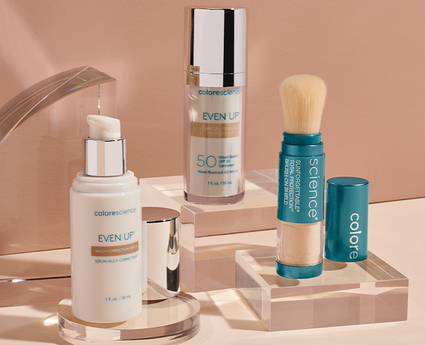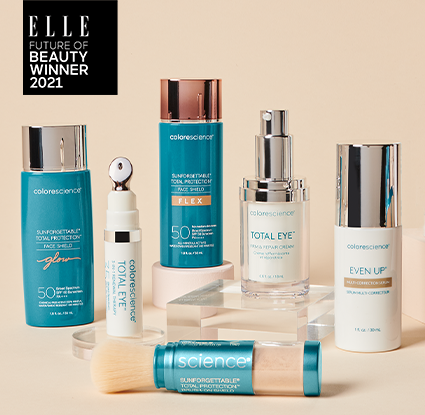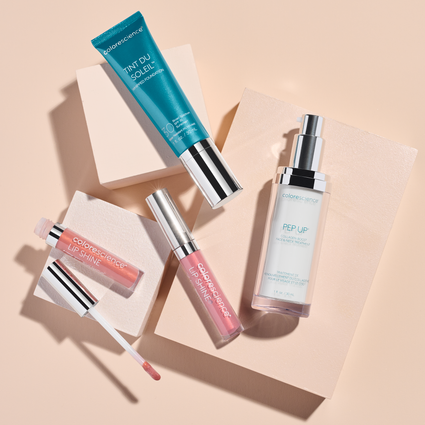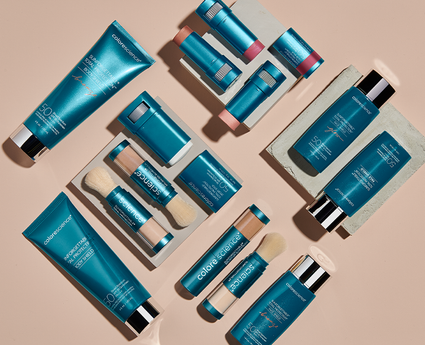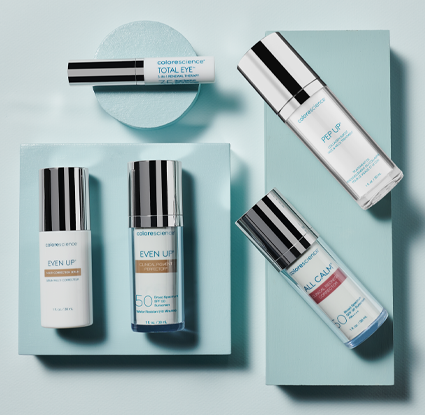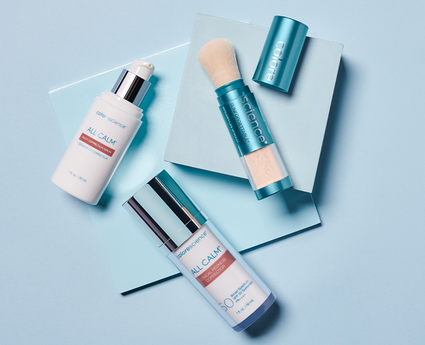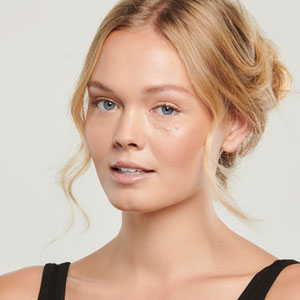Crow’s Feet: What Is It & How to Get Rid of Crow’s Feet
The skin around your eyes is the thinnest on your body and typically the first area of the face to develop fine lines, divots, and creases. But is there anything we can do to prevent them or to reduce the appearance of crow’s feet once they’ve set in?
While loss of skin laxity is a natural part of life that can’t be avoided — it can be delayed. Learning how to get rid of crow’s feet can be done, and we’ve compiled various crow’s feet treatments you can try, ranging from a natural acid to eye renewal cream, store-bought products to professional procedures.
First, we’ll break down what causes crow’s feet, then we’ll dive into advice on how to prevent them.
- What Are “Crow’s Feet”?
- What Causes Crow’s Feet
- How to Prevent Crow’s Feet
- How to Fix Crow’s Feet
- How to Get Rid of Crow’s Feet without Botox
- Treat Crow’s Feet with Colorescience
- A Skincare Regimen for Addressing Crow’s Feet
- Which Crow’s Feet Treatment Is Right for Me?
- How to Conceal Crow’s Feet
What Are “Crow’s Feet”?
Now, you may be wondering: what are “crow’s feet” and how do they develop? Below we’ve explained the basics of crow’s feet and how to better care for your skin.

To start, crow’s feet are the thin lines that you begin to see form around your eyes, primarily the outer corners. You may be curious as to why they are called crow’s feet. When these fine lines form, they often appear as a crow’s foot on the outer corner of your eyes, hence “crow’s feet”.
According to the American Society of Dermatologic Surgery, there are two types of crow's feet to look for: dynamic lines and static facial lines.
- Dynamic lines are associated with your underlying muscles. Therefore, every smile, frown, or facial expression you make contributes to your dynamic lines, as they are outlined around those expressions. This is the most common type of crow’s feet wrinkles because typically every person has them, and some may grumble about the stubborn ones on their forehead from squinting.
- Static facial lines are present all the time. This type of crow’s feet wrinkles develop from sun damage, squinting, or frowning for more extended periods.
One thing to note about these two is dynamic lines essentially ‘disappear’ after you stop making the facial expression, but static lines are long-lasting.
On average, humans blink approximately 10,000 times per day; constant movement of skin around the eye area is inevitable. Expression lines usually begin to develop between the ages of 20 and 30, but learning how to prevent crow’s feet early on can significantly delay their development
What Causes Crow’s Feet
Before learning how to get rid of crow’s feet, we first need to understand what causes wrinkles. By getting to the bottom of crow’s feet causes, you’ll be best equipped to prevent their formation.
“Laugh lines”, “expression lines”, or “character lines” are caused, in part, by our habitual facial expressions.
But how do temporary muscle contractions when smiling or squinting result in permanent fine lines? Let’s take a look at the science behind wrinkle formation to understand.
Your skin is composed of three layers:
- Outermost epidermis
- Inner dermis
- Subcutis beneath the skin
When we refer to “wrinkles”, we’re talking about the creases or depressions seen on the epidermis, but the real action goes on below the surface.
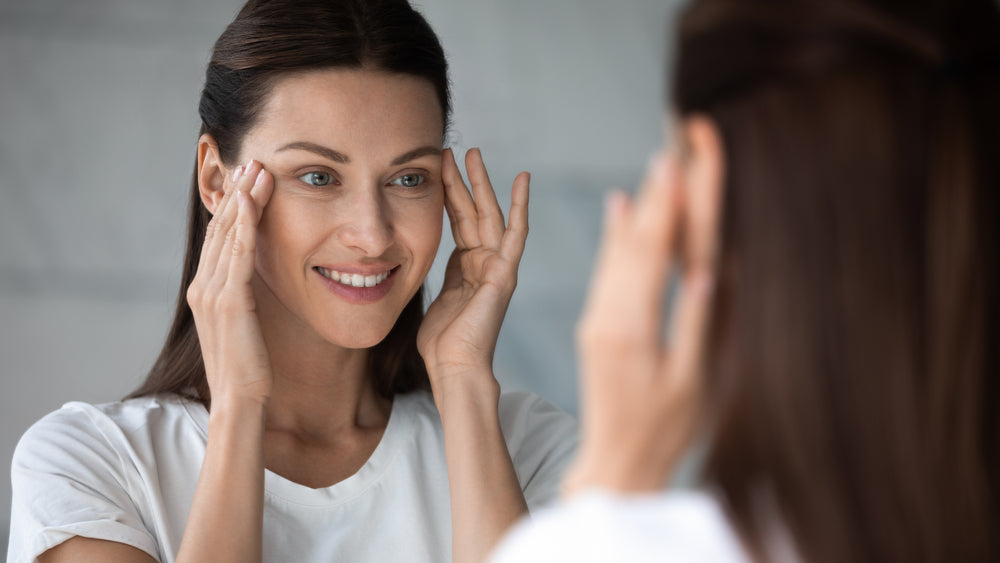
The dermis is the main layer of skin that causes crow’s feet and wrinkles; it’s a complex combination of blood vessels, hair follicles, and sebaceous (oil) glands. More importantly, this layer is where you’ll find collagen and elastin—two essential proteins for preventing crow’s feet.
- Collagen is the most abundant protein in our bodies, made up of various amino acids. It’s found within connective tissue and is responsible for giving structure to the body’s skin, hair, nails, bones, ligaments, and tendons. Most importantly, it provides the skin cells’ strength and volume.
- Elastin is another protein found within the dermis and connective tissue. It has an elastic property which enables skin cells to resume their shape and ‘snap back’ after being stretched, contracted, poked, or pinched.
The subcutis (or bottom layer of skin) hosts sweat glands, loose connective tissue, and most importantly, fat. When this fatty layer is reduced, it can cause crow’s feet, wrinkling, and overall sagging.
Altogether, the three levels of the skin are made up of various components, including:
- Water
- Protein
- Lipids
- Minerals
- Chemicals
- Enzymes
These elements are constantly in flux throughout the course of our lives. As we age, the biological changes within our skin cells are what cause crow’s feet and other wrinkled skin across our body. The genetic alterations that lead to crow’s feet include:
Protein Breakdown
Over time, our body loses its ability to produce and break down certain proteins, causing their presence to gradually shrink. Collagen typically accounts for 75% of the skin organ, but as this ratio decreases, our skin loses its support and suppleness. Collagen fibers supply the scaffolding to hold skin up, and an enzyme called collagenase (part of a larger group of Matrix MetalloProteinases or MMP enzymes) assists by breaking down old or damaged collagen so new proteins can take its place.
While we’re young, collagen breaks down at the same rate it’s produced, but as we age, production slows while degradation increases. In fact, by age 20, our skin naturally produces 1% less collagen per year. The net result is less new collagen and decreased existing collagen.
Similar to collagen, elastin production is also influenced by time and elements. With age, elastin doesn’t retract as much once stretched. Like an old rubber band, it remains lax instead of snapping back, causing crow’s feet to droop along the outer eye area. Learn how you can combat this and more with these additional tips to look younger.
Less Fat
Natural aging decreases the fat within the subcutis. When fat is lost on the face, it reduces facial volume, meaning there’s less surface ratio for the skin to cover. We still have the same amount of skin, however, which causes the tissue to drape over itself and create folds or wrinkles.
Gravity can also be added to the list of crow’s feet causes since weakened skin without support will simply sag downwards.
Sebum Reduction
The older we get, the slower our sebaceous glands produce sebum. Sebum is the sticky, secreted oil intended to form a protective barrier around the skin—the body’s largest organ—by retaining moisture and shielding against free radicals. Moisture is a key element to preventing crow’s feet; when skin is dry and brittle, it’s more prone to structural manipulation.
Fewer GAG’s
Glycosaminoglycans (GAGs) are water-binding sugar molecules within the fluid matrix found between the dermis and epidermis. They’re responsible for giving skin its plumpness by filling the space between collagen and elastin fibers, providing support and keeping them plump and upright.
In addition to protein, fat, and oil, GAGs are another factor behind what causes crow’s feet and is affected by age. With less water and volume, skin eventually becomes ‘deflated’, so to speak, and more prone to causing crow’s feet.
What causes crow’s feet, in particular, are the wrinkles due to motion and muscle movement — as opposed to the wrinkles at rest, which appear regardless of motion and are caused by intrinsic and photoaging. At a certain point, based on various factors discussed in depth below, the repeated movements eventually create deep enough wrinkles that appear even when no expression is made.
With contextual knowledge as to how wrinkles form, you’ll be savvier regarding how to remove crow’s feet and prevent them from occurring in the first place. Some of the aging processes are inevitable, while others can be exacerbated by lifestyle choices and the environment. Let’s take a look at how to prevent crow’s feet by applying knowledge of wrinkle formation.
What Age Do You Get Crow’s Feet?
After learning about crow’s feet you may be curious about when they begin to develop. As stated in this article, these expression lines tend to develop between the ages of twenty and thirty. However, you may want to consider that the given age range is a suggestion, crow’s feet can form at any age depending on:
- Your genetics
- Skincare routine
- Sun exposure
- Treatments
If you want to delay the process of crow’s feet you may want to consider implementing a strong skincare regimen.
Some of the aging processes are inevitable, while others can be exacerbated by lifestyle choices and the environment. Let’s take a look at how to prevent crow’s feet by applying knowledge of wrinkle formation.
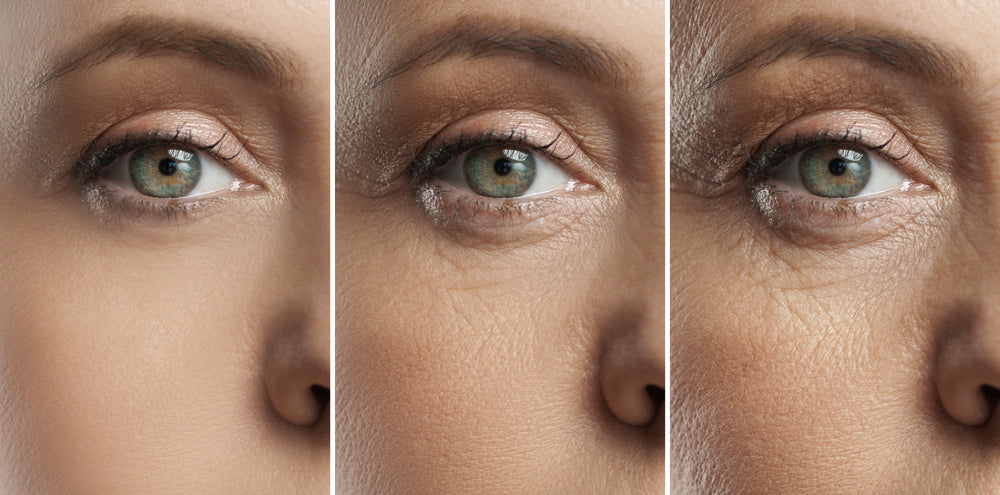
How to Prevent Crow’s Feet
Intrinsic aging, otherwise known as chronological aging, is an inherent part of life. Although it can’t be avoided altogether, it can be significantly delayed now that you’re armed with the knowledge of the essential proteins, fat, sebum and sugars within the structure of the skin.
Combine what you’ve learned with these tips on how to prevent crow’s feet in order to prolong the appearance of character lines.

Follow a clean diet
One of the best things you can do for the vitality of your skin—and your overall health—is to follow a healthy diet that provides an ample amount of fat (but stick to the good kinds!).
Unsaturated fats (including both monounsaturated and polyunsaturated fats) offer the body many benefits, including lower cholesterol levels and reduced risk of heart disease, but they also help keep your face soft and voluminous. If you’re looking for a simple solution for how to prevent crow’s feet, try to eat more foods such as:
- Fish rich in omega-3s essential fatty acids such as salmon and other cold-water species
- Avocados
- Nuts and seeds
- Extra virgin olive oil
Watch Your Sugar Intake
With respect to diet, make sure to not only incorporate good foods but to also avoid unhealthy ones—particularly sugar—to prevent crow’s feet. Excess sugar levels within the bloodstream bind to collagen, thereby rendering it dysfunctional through a process called glycation.
Sugar also generates inflammation, which releases the floodgates of those aforementioned MMP enzymes that break down protein. Limit your sugar intake wherever possible, and resist irritating and inflaming your skin by rubbing your tired eyes in the morning, for example.
Quit Smoking
If you’re still smoking, it’s time to stop. Tobacco smoke is a massive accelerant for premature aging and can force you to seek crow’s feet treatment far sooner than non-smokers. Not only does smoking (and being near second-hand smoke!) trigger the inflammation process, it also introduces free radicals into your system which can linger for days.
Purchase Reading Glasses
Any repeated facial expression involving the skin around your eyes contributes to crow’s feet, especially squinting. As you age and begin to experience a decrease in vision, be sure to pick up a pair of reading glasses to keep your eyes wide and wear them whenever needed.
Squinting at your computer screen at the office or struggling to read the text of a book at home is one of the leading crow’s feet causes, so be sure to avoid this bad habit.
Don’t Over-Wash Your Face
This might sound counterintuitive, but harsh tap water strips skin of its essential moisture, natural oils, and protective lipids which help prevent crow’s feet and wrinkles — especially if the water is hot. By washing your face too often, you wash away its protective barrier. When you do cleanse within your skincare routine, be sure to use a gentle cleanser with cold water and immediately follow up with a hydrating moisturizer.
Limit Screen Time
It can be difficult to accept, but the blue light emitted from our screens can speed up skin aging, especially around the eye area.
Blue light can damage skin cells and lead to the breakdown of collagen and elastin—the essential proteins that keep our skin looking firm and youthful. This can accelerate the formation of fine lines and wrinkles.
Plus, blue light can mess with our sleep patterns, which doesn’t help either, as a lack of sleep can make skin look dull and cause dark circles to appear under the eyes.
To help protect your skin from the effects of blue light, it can be beneficial to limit your screen time (as much as you can manage) and consider using blue light filters on your devices. And don’t forget to wear sunscreen every day, even when you’re indoors, as sunscreen can help protect against the damage that blue light causes.
Wear Sunscreen
Sunscreen is paramount when researching how to prevent crow’s feet. Unprotected sun exposure is the number one cause of premature aging. Exposure to UVA and UVB sun rays leads to an acceleration of wrinkle formation and weakening of skin vitality.
Radiation is well-known for damaging DNA and proteins due to harmful free radicals. Instead of asking yourself how to get rid of crow’s feet, start applying sunscreen on your face and wearing a minimum of SPF 30 broad-spectrum sunscreen every time you step outside.
Remember that UV rays can penetrate car window glass and even the cloudiest of skies, so there’s no excuse for not applying sunscreen.
On average, humans blink approximately 10,000 times per day; constant movement of skin around the eye area is inevitable. Expression lines usually begin to develop between the ages of 20 and 30, but learning how to prevent crow’s feet early on can significantly delay their development.
To minimize your need for crow’s feet and wrinkle treatment, start implementing these easy tips as soon as possible—your eyes will thank you later.

If you are unsure about where to start, you may want to consider looking at the various types of sunscreen available. As many of us know, face sunscreen and body sunscreen vary in formula and strength.
Mineral sunscreen is a great option for proactive and reactive anti-aging skincare as mineral sunscreens are made with the actives zinc oxide and titanium dioxide which have natural anti-inflammatory properties that will help soothe and protect skin without irritation.
When it comes to creating a skincare regimen best suited for you, it may be challenging to determine which products are necessary for your skin. Sunscreen is a product that is highly recommended for every person to utilize. Not only does it help protect your skin from the sun every single day, sunscreen helps prevent wrinkles. I’m sure you’re wondering: how does sunscreen prevent wrinkles? Well, with the correct broad-spectrum (30+), PA++++ rating, non-toxic ingredients, and applied effectively throughout the day, sunscreen should prevent and delay the process of crow’s feet wrinkles, and aging.
Even if you typically wear a full face of makeup, that’s not enough to protect your skin from sun exposure. Sunscreen is still a priority, and to make it easier, Colorescience offers sunscreen options that double as mineral cosmetics to simplify your daily routine.
Make sure you’ve cleansed your face before applying sunscreen and SPF makeup, your skin will thank you later.
To minimize your need for crow’s feet treatment, start implementing these easy tips as soon as possible — your eyes will thank you later.
How to Fix Crow’s Feet
If your character lines have already developed, not to worry: figuring out how to get rid of crow’s feet is generally simpler than eliminating the pronounced grooves or furrows found elsewhere on the face. A crow’s feet treatment regimen attacks the fine lines found in the skin around your eyes, which are generally shallow and easy to reach.
They do deepen with age, however, so it’s best to begin your crow’s feet treatment as soon as possible. There are several different treatment options you can use to get rid of crow’s feet, from natural home remedies, to over-the-counter solutions like firming eye creams, to professional cosmetic procedures.
Foods for Healthy Skin
We already stressed the importance of diet for crow’s feet prevention, but if you’re trying to figure out how to get rid of crow’s feet which have already formed, food may still be a helpful solution.
- In addition to protecting your skin, soy may actually help improve its appearance. When taken as a supplement (versus consumed), it can heal sun damage and help your skin’s structure and firmness.
- Cocoa is a tasty, wrinkle-reducing drink if it contains high enough levels of catechin and epicatechin. These two antioxidants help improve oxygen circulation and blood flow to skin cells, retain moisture, and make your complexion look and feel smoother.
- Another beverage worth your consideration is a glass of water containing a tablespoon of aloe Vera consumed; consume twice daily to receive the benefits of its antioxidant properties. Alternatively, squeeze the gel of a fresh aloe Vera leaf and apply it topically around the eyes for noticeably firmer skin and less visible crow’s feet.

How to Get Rid of Crow’s Feet without Botox
If natural ingredients and home remedies aren’t cutting it, you can also learn how to get rid of crow’s feet using stronger, store-bought products before jumping to expensive cosmetic procedures. To reduce the appearance of crow’s feet more affordably than at a doctor’s office, consider adding these skincare solutions to your routine:
Eye Creams with Vitamins and Minerals
You might be surprised to find that there are incredibly effective eye creams for crow’s feet which are packed with vitamins and minerals. Look for labels that contain:
- Peptides: Short chains of amino acids called peptides are often found within eye creams to treat crow’s feet for their ability to signal collagen production and assist with essential cellular activities.
- Caffeine: A naturally occurring stimulant that’s found in coffee beans, yerba mate leaves, and more. Caffeine can help you look awake, boost circulation, and reduce puffiness while tightening and brightening the skin.
- Hyaluronic acid: This naturally occurring chemical is often used in skincare because it helps replenish moisture.
- Squalane: Derived from squalene which is a lipid produced by the body, squalane is a hydrating ingredient that is anti-aging and promotes skin barrier health.
- Sea buckthorn fruit oil: An oil found in seeds of the sea buckthorn plant, sea buckthorn fruit oil is a powerful botanical humectant. Because of its high levels of vitamins and minerals, it can improve skin hydration and elasticity, while also soothing the skin.
Our Recommendations
Total Eye® Firm & Repair Cream
The Total Eye® Firm & Repair Cream is our award-winning eye treatment designed to address multiple concerns around the notoriously delicate eye area. This cream contains SYN-EYE®, a potent blend of peptides and vitamins that target various eye-related issues, including:
- Puffiness
- Dark circles
- Fine lines and wrinkles, like crow’s feet
The peptides in this cream work to stimulate collagen production, which is essential for maintaining skin elasticity and reducing the appearance of crow's feet. Meanwhile, ingredients like sea buckthorn oil, meadowfoam seed oil, and squalane provide nourishment and antioxidant protection to the sensitive eye area, helping to prevent further damage and promote overall skin health.
Total Eye® 3-in-1 Renewal Therapy SPF 35
Total Eye® 3-in-1 Renewal Therapy SPF 35 is our tinted multitasking eye serum. It corrects imperfections by instantly brightening the under eyes, addresses underlying skin concerns by providing hydration and improving appearance of under eyes over time, and protects under eyes from UV rays with SPF 35.
This formula helps reduce the appearance of crow’s feet in the short term and long term and helps prevent further development of crow’s feet that may be exacerbated by sun exposure.
This formula also contains SYN-EYE® to provide the peptides and vitamins that help to deeply nourish the skin. Available in 4 different shades, it’s best applied after skincare and under makeup, as it contains makeup priming ingredients.
Total Eye® Hydrogel Treatment Masks
Total Eye® Hydrogel Treatment Masks are masks that you apply to your under-eye. Get relief from tired-looking eyes with these hydrogel masks that provide an intense boost of hydration to instantly minimize the appearance of dark circles and puffiness.
Use the hydrogel masks in combination with Total Eye® Firm & Repair Cream to lock in hydration and before Total Eye® 3-in-1 Renewal Therapy for smoother application.

Plumping Products
To get rid of crow’s feet, you should consider products which can plump up your skin without invasive injections or fillers. The best way to do this is to search for water-binding ingredients, known as humectants, which supply your skin the hydrating boost it needs.
Humectants act like sponges which absorb water and mimic the effect of GAGs within the dermal fluid, keeping them plump and upright. Reduce the appearance of crow’s feet and smooth out wrinkles with moisturizing, humectant ingredients such as:
- Hyaluronic acid
- Glycerin
- Sorbitol
- Propylene or Butylene glycol
Our Recommendation
Pep Up® Collagen Boost Face & Neck Serum
This potent anti-aging serum has no shortage of humectants, as it contains:
- Hyaluronic acid
- Glycerin
- Sorbitol
- Butylene glycol
We specifically formulated it to target crow's feet and other signs of aging around the face and neck. The combination of peptides, vitamins, and hydrating compounds works together to:
- Stimulate collagen production
- Improve skin elasticity
- Deeply moisturize the more sensitive eye area
It also features a unique blend of marine extracts and plant-derived ingredients that further support skin renewal and help protect against environmental stressors. By addressing multiple causes of skin aging, you can count on this powerful formula to assist in diminishing the appearance of crow's feet and help promote a more youthful, radiant complexion.
Laser Resurfacing
Another remedy you may want to consider for crow’s feet wrinkles is laser resurfacing. This treatment requires several days for your skin to heal, but many rave about the results. This process specifically targets your crow’s feet area by intensely heating the skin to force your body to produce collagen, leaving you with a smoother appearance.
While many people are fans of laser resurfacing, it might not be the right treatment solution for everyone. Before making a decision, you may want to consider researching the process. Speaking with your dermatologist is also usually a good idea, so they can recommend the best course of action based on your skin and your concerns.
Treat Crow’s Feet with Colorescience
When eye creams and serums don’t achieve the desired success for crow’s feet treatment, many begin considering cosmetic procedures using injectable fillers such as Botox. Before resorting to Botox—which is both expensive and difficult to maintain — be sure to try Total Eye® 3-in-1 Renewal Therapy SPF 35 first.
With powerful clinical ingredients, this product can deliver immediate results and long-term improvement. Not only does it correct your skin and get rid of crow’s feet, but it also helps protect your delicate complexion with broad-spectrum SPF.
There are various Colorescience eye creams to choose from, including firming, hydrating, and tinted products; there are even some specifically for crow's feet. If your goal is to use natural ingredients to delay and treat crow's feet wrinkles, you may want to try them. Each eye cream is intended to hydrate and moisturize the most sensitive area around your eyes.
Learn more about the various eye cream formulas we offer to see which is right for your needs.

A Skincare Regimen for Addressing Crow’s Feet
If you want to address crow's feet but don’t know how or when to use certain products to get the best results, we’ve got you covered. Here’s a daily routine you can try that combines specialized eye treatments, serums, and broad-spectrum sunscreen to help you achieve smoother, more youthful skin.
- Cleanse your face thoroughly with a gentle cleanser.
- Apply Total Eye® Firm & Repair Cream under the eyes, gently patting it in.
- Apply Pep Up® Collagen Boost Face & Neck Serum to the face and neck, focusing on areas with fine lines.
- Hydrate your face with a suitable moisturizer for your skin type.
- Apply a mineral sunscreen, like Sunforgettable® Total Protection® Face Shield Flex SPF 50.
- Reapply sunscreen every two hours, especially when outdoors. For touch-ups throughout the day, Sunforgettable® Total Protection® Brush-On Shield SPF 50 is easy to apply on the go with its built-in brush.
Which Crow’s Feet Treatment Is Right for Me?
Selecting the most appropriate treatment for crow's feet can depend on a few factors:
- Severity of crow's feet: Mild to moderate cases often respond well to at-home skincare solutions like the Total Eye® Firm & Repair Cream and Pep Up® Collagen Boost Face & Neck Serum. Deeper wrinkles might require professional cosmetic treatments.
- Skin type and sensitivity: Those with sensitive skin may need to start with gentler formulations or patch test new products.
- Age and skin condition: Younger people may benefit more from preventative measures, while more mature skin might respond better to more intensive treatments.
- Lifestyle factors: Things like sun exposure, diet, and smoking can influence the effectiveness of treatments and the progression of crow's feet.
- Budget and time commitment: Some treatments require more frequent application or higher financial investment than others.
- Personal preferences: Some people may prefer non-invasive topical treatments, while others might be open to more in-depth procedures.
If you can, it’s always advised to consult with a dermatologist to discuss your specific concerns and goals for your skin. A professional can help properly assess the condition of your skin, consider your medical history, and recommend a personalized treatment plan that could include a combination of at-home treatments and in-office procedures for the best results.
How to Conceal Crow’s Feet
Here’s the deal: you have learned a lot about crow’s feet, but now it’s time to learn one more trick you’ll want to have in your arsenal: how to conceal them. Concealing crow’s feet helps make them less noticeable and can boost your confidence.
As with any kind of wrinkle, you’ll want to find a formula that isn’t going to set into the lines. To get you started on the right track, try pairing our Total Eye® 3-in-1 Renewal Therapy, mineral foundation SPF 30, and Even Up® Clinical Pigment Perfector® SPF 50 together.
With proper skin care and safe ingredients, you’ll be set to take on crow’s feet. To get started, you’ll need a high-quality eye cream, such as the ones mentioned above, and a solid primer or serum. With the help of Colorescience you have various eye creams to pick from and an excellent multi-correction serum to help you take on your crow’s feet concerns.
Combat Crow’s Feet & Restore Your Confidence
Don’t let fine lines make you look older than you feel; use these tips and learn how to get rid of crow’s feet for a radiant complexion. Crow’s feet should never define you, but if you want to find ways to overcome them so you can feel confident and comfortable in your skin, look no further. Colorescience skin treatments and sunscreen are formulated with natural ingredients and the health of your skin in mind.

